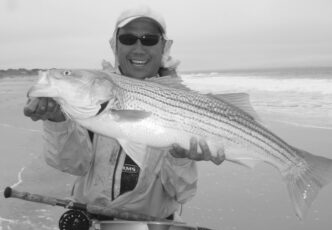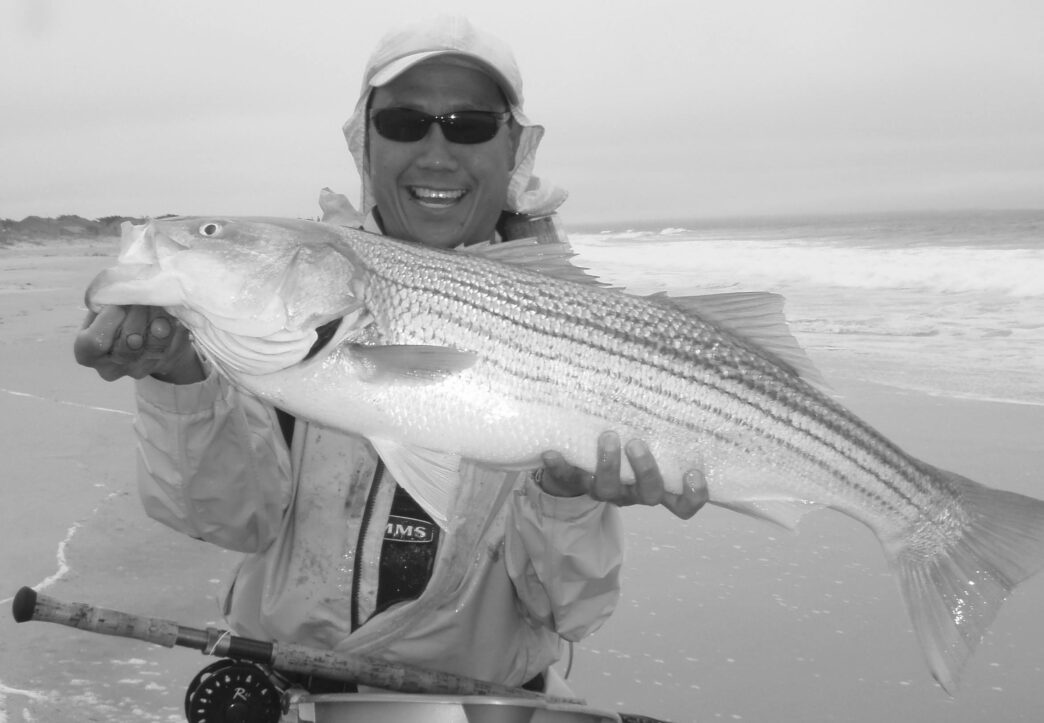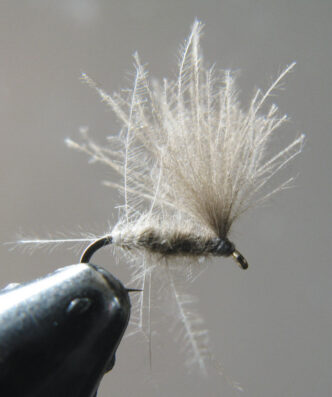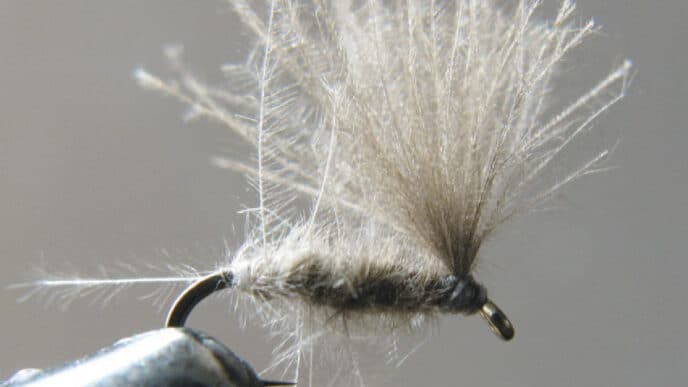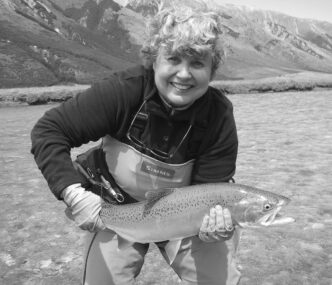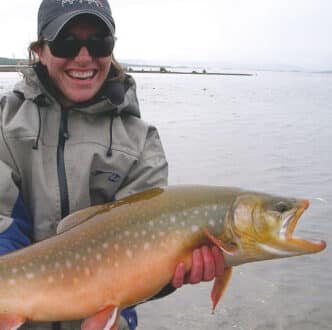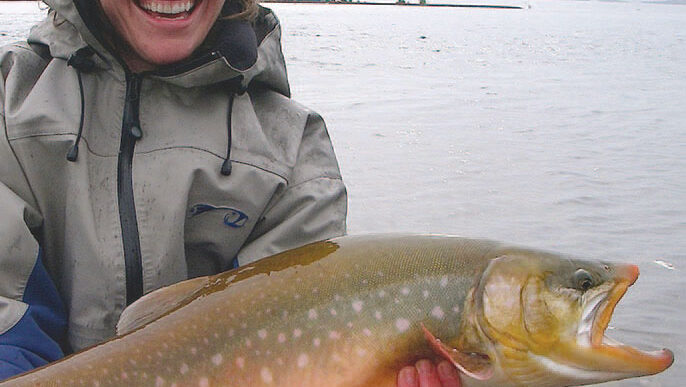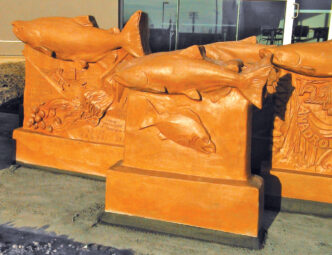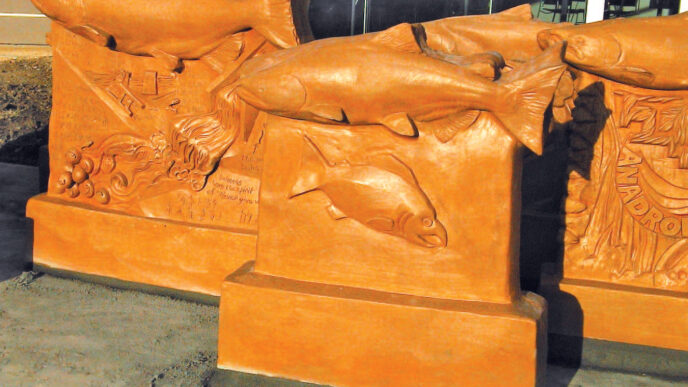People come to fly fishing in all kinds of ways. Some for whom it was no more than a curiosity, at best, eventually become long-rod fanatics. Such was the case with surf-zone angler and website host Mark Won. These days, flyrodders in the surf zone are becoming more common, but when you meet one, you might be surprised what brought them to the beach. Once there, however, all undergo the kind of learning process that Mark Won endured. He now makes what he has learned available to others in Fly Fishing the Surf at his website, html, and he shares his experiences with us in this interview.
Bud: What brought you to the beach with a fly rod in hand?
Mark: Boy, that’s an excellent question. From a “traditional” fly-fishing perspective, it would probably seem odd that I’d prefer to concentrate on fly fishing the surf over the numerous lakes, rivers, and other inland bodies of water situated in and around the Bay Area.
There are a multitude of reasons why I visit the ocean so much. For one thing, it’s a great way to escape the heat during the summer. And the salty marine air naturally suppresses the seasonal pollen that aggravate my allergies, especially in the spring. Geography also plays a significant role. The Pacific coastline presents miles of accessible shoreline within easy traveling reach from where I reside in the Santa Clara Valley.
But a deeper explanation as to why I’m drawn to the beaches lies buried somewhere in my angling origins. As a kid growing up on the island of O’ahu, Hawaii, I was exposed to inshore saltwater fishing beginning at a very early age. These are what I often refer to as my hanabata or childhood days. It was a magical period of angling discovery, one that many readers can probably relate to, based on their own experiences. First, a little bit of family history. . . .
My ancestral roots are tied to the first or second wave of immigrants that settled in Hawaii from China during the mid to late nineteenth century. After residing on the windward side of O’ahu for many years, my great-grandparents (mother’s side) eventually moved to the outskirts of Waikiki, where my grandparents raised the family. For several decades, the family owned the largest duck farm on the island and managed a general store, which still exists to this day at the corner of Hobron Lane and Ala Moana Boulevard, across from the Ilikai Hotel.
In the years leading up to the Second World War, Waikiki was a mixture of both swamp and overgrown, dry brush. Thorny acacia trees and muddy flats preceded the now-familiar stretch of sandy beach stretching ewa (or westward) of the picturesque Diamond Head landmark. A quiltwork of interconnected fish ponds, flooded rice fields, and taro patches occupied the marshes in the low-lying portions of Waikiki. The Manoa and Palolo streams that flowed down from the Koolau range periodically inundated these areas during the rainy seasons. Eventually, the Ala Wai canal was constructed in the early 1900s to drain the mosquito-laden swamps and prevent further flooding.
According to the stories passed down in the family, the waters surrounding Waikiki were abundant with fish. Mullet and milkfish were raised in the duck ponds long before the condos and high-rises overran the swampy landscape. Schools of large bonefish and trevallies were common among the reefs fronting today’s tourist oriented waterfront. My grandfather, “Grampa Joe,” was quite the avid fisherman and spent a great deal of time fishing to supplement his meager income as a lumber mill operator and carpenter. During the Great Depression, subsistence farming and fishing were common in the islands. For many island residents, fishing is integral to the family lifestyle, rather than a recreational activity. Hawaii’s tourist economy wouldn’t establish itself until after the Second World War.
Grampa Joe was the consummate hard-core angler. He fished by day and night, rain or shine, from shore and boat. It was a trait that was passed onto the menfolk in the family, including me. There’s an often-repeated family tale about Grampa Joe’s memorable fishing adventure off the shores of Waikiki one eventful Sunday morning. It was December 7, 1941. Despite the dark, oil-fueled smoke rising above Pearl Harbor and the sound of artillery firing in the distance, he continued to tend his fishing nets, thinking it was merely another military exercise taking place. All of that quickly changed when misdirected artillery and antiaircraft shells suddenly began exploding in the water nearby. Needless to say, it was one of the few times Grampa Joe foreshortened what would’ve been a typical all-day fishing excursion.
Some of my earliest and fondest memories involve fishing Grampa Joe along the banks of the Ala Wai. Our family and close relatives used to live within a few blocks of the canal and nearby beaches of Waikiki. Together with my cousins, we’d tag along with Grampa Joe toward the Ala Wai, carrying buckets and bamboo poles as he set out to catch his dinner.
The Ala Wai was once a thriving canal. Years ago, its brackish water harbored a variety of fish. Schools of mullet and milkfish would swim up and down the canal, especially on the incoming tide. When the a’wa (milkfish) were running, clumps of silky brown limu (a type of mossy seaweed) would often grow along the rocky ledges of the canal. Clumps of limu would periodically break loose and float around the Ala Wai. This is what attracted the milkfish to the canal, especially during the cooler rainy seasons.
Grandpa Joe knew how to catch the wily and temperamental, yet strong, forktailed a’wa. His tackle was basically a long, 12-to-15-foot homemade bamboo pole tipped by 30-pound or heavier monofilament terminated by a size 1/0 or larger stainless steel hook. I remember one particular afternoon when I accompanied him to one of his favorite a’wa holes along the Ala Wai. I was about four or five at the time. During low tide, we hand-picked a bunch of limu and stored the stinky seaweed in a bucket to use later for bait.
After collecting our share of limu, we set up our poles beneath one of the shady banyan trees that grew (and still do) along the canal. After wrapping our hooks with a few clumps of the silky seaweed, we lobbed our baited lines into the brackish water, set the poles in a special homemade holder that straddled the parapet, then watched the bright orange pencil bobbers as they slowly drifted with the incoming tide.
I don’t recall exactly how long we waited for the fish to bite. During the lull, Grampa Joe would periodically remind me to pull up my line and recast whenever my bobber wandered past a certain location along the canal. Suddenly, I saw the orange pencil float below his pole submerge unexpectedly. “You’ve got a bite!” I yelled excitedly. He saw the bobber sink, too, and quickly lifted up his bamboo pole from the holder to set the hook. But the line at the end of the pole was lifelessly limp. The fish’s soft mouth had missed the hook.
Several seconds later, my bobber went under. “Pull your pole up!” Grampa Joe instructed. At first, I felt nothing. Then the pole’s tip became heavy — something began to shake violently at the other end. I immediately knew I had a fish on. I was so excited by the thrill of feeling the a’wa thrashing on the other end of the line — it was just me versus the fish. I kept a tight grip on the pole’s handle throughout the ensuing battle. Grampa Joe was right beside me, coaching me to lead the fish toward his long-handled net. With one swift scoop, he netted the a’wa and lifted it over the parapet. What a fish!
Somewhere in our family’s collection of faded photos, there’s a Polaroid black and white picture of me holding up the a’wa. The milkfish was about as long as I was tall and probably weighed nearly as much as I did at the time. That experience, along with many others in my early childhood, helped nurture my passion for inshore saltwater fishing that continues to this day.
By the time I entered high school, I’d already traded the bamboo pole for a spinning outfit. Until I left for college in northern Arizona, I’d frequently join my dad or school buddies to pursue numerous species of saltwater game fish on spinning gear. Some of our favorite quarry included jack trevallies, bonefish, barracuda, ladyfish, surgeonfish, parrotfish, triggerfish, and goatfish, just to name a few. We’d occasionally wade the reefs at low tide to cast weighted lures past the outer break in hopes an u’lua (great trevally) would emerge behind a cresting wave and crush a rapidly retrieved baitfish imitation.
When it came to chasing the high pursuit predators, such as the ladyfish and jacks, I often “whipped” the inshore waters. In local angling parlance, the term “whipping” meant casting and retrieving at a very fast rate using ultralight spinning gear. A 6-to-7-foot-long, fast-tapered graphite rod combined with a 6-to-1 gear ratio spinning reel spooled with 1-pound to 4-pound test line was considered ideal for this style of angling. Before the advent of fluorocarbon, it wasn’t too uncommon for line-shy game fish to refuse a baited hook or lure connected to 6-pound-test and heavier monofilament. But with the 2-pound or 4-pound-test mono on ultralight spinning gear, a wary jack or ladyfish could be enticed into mindlessly attacking a hook rigged with a few strips of colored plastic when ripped erratically across the water’s surface.
After finishing college in Northern Arizona, I moved to the San Francisco Bay Area in 1986. Upon settling in the South Bay, I was anxious to return to my saltwater fishing ways. Though I’d previously dabbled in freshwater fishing while in college, I sorely missed smelling the salty, briny air wafting off the ocean. Since a number of the Bay Area’s beaches and coastline areas could be easily covered in a day, I made a conscious effort to learn about the different shore fishing opportunities they offered. In a few years, I began to recognize and associate the commonalities and differences between Northern California’s surf fishing and the familiar inshore fishing I had known during my youth in Hawaii. Over the course of a few years following my arrival in the Bay Area, I began to pick up and absorb the angling vibe that permeated the region.
During those pre-Internet days, most of the local angling knowledge I sought to acquire came in the form of print and by word of mouth. In talking with various fishermen and reading whatever information was publicly available at the time, I eventually learned about the diverse habitats, seasonal reproductive cycles, migration habits, and other factors associated with the Bay Area’s marine fishery. The striped bass, salmon, surfperch, leopard sharks, rockfish, lingcod . . . these were on my short list of fish to target from shore. During those early years, I employed a diverse variety of angling gear and methods practiced by many in the Bay Area’s fishing community.
I wanted to try it all — spinning, conventional fishing, poke-poling, and eventually, fly gear. For a while, I nearly took up abalone diving. Despite having donned a mask and snorkel while spear fishing as kid in Hawaii, I decided against taking up prying mollusks from a rock with a diving iron — too much work! Besides, hearing about the various encounters by local surfers and divers with the “tax collector” (the great white shark) in waters encompassed by the Red Triangle really put the kibosh on the notion.
In the two decades or so that I’ve spent traipsing miles of beaches, often in leaky waders and getting splashed by the waves in search of the tug on the end of the line, that special connection to my angling heritage has always remained intact. My inclination to head west toward the coastline and fish the beaches is probably driven by the enjoyment I experienced during my youthful hanabata days. In retrospect, fishing the surf reminds me of my roots. I suppose I’m simply nostalgic and sentimental, in that regard.
Bud: It was way back in 1992 that you took Ken Hanley’s class on fishing the surf, but you’ve said that it wasn’t until “several years” later that fly fishing in the surf seemed like an option for you. Had you fly fished previously? What attracted you to fly fishing the surf?
Mark: Fly fishing didn’t really enter the picture until around my junior year in high school. Up until that time, I’d barely spent any time fishing in fresh water, for that matter. There were a few freshwater impoundments on Oahu that contained prolific schools of tilapia. We’d catch those by the bucketful with light spinning gear on hooks baited with bread dough. Otherwise, my only exposure to fly fishing was whatever I read in Field and Stream and other fishing magazines at the time.
One summer while still in high school, I accompanied family relatives on a cross country camping trip. The adventure included the upper northwest quadrant of the country, between Washington State and Montana. Every park or campsite we visited featured a nearby lake, pond, river, or stream containing stocked or native fish. We spent at least a few days fishing each location. I especially recall fishing the lakes and major tributaries of the Uintas, Rocky Mountains, Yellowstone, Jackson Hole, and Glacier National Park. I had a great time fishing the farm ponds of Nebraska for bass, carp, and catfish.
I remember an uncle or cousin hauling out the lone fly rod that was packed with us whenever we visited trout water. That was the first time I’d personally witnessed someone fly fishing. Compared with spin fishing, fly fishing initially seemed like an exotic form of angling to me. Watching a person fly cast endlessly for something I couldn’t see just looked like work. I was quite content to catch fish with a glob of marshmallow or a string of salmon eggs threaded onto a hook. However, that initial encounter with the fly rod had piqued my interest.
In the early 1980s while attending a small university in Prescott, Arizona, I eventually made my first attempt at fly fishing. During the weekends when I’d caught up on my studies, I’d sometimes ride my mountain bike carrying my fishing tackle to one of the nearby lakes surrounding the campus. In my first semester, I discovered that bluegills, crappies, and largemouth bass inhabited a few of the freshwater impoundments. Naturally, my first inclination was to rely on the trusty ultralight spinning gear I’d brought with me from Hawaii. For a while, everything was hunky-dory. The crappies, sunfish, and bass would obligingly take whatever I put in front of them, be it a jig, spinner, or plastic worm.
Either out of boredom or sheer curiosity, I needed a more challenging, entertaining way of engaging these fish. This is when I took my first, albeit, hesitant, steps in fly fishing. I think it was during my second year in college that I picked up a fairly inexpensive fly-fishing combo. The set-up included a 6-weight rod equipped with a Cortland fly reel spooled with a weight-forward floating line. I really had no clue as to what I’d just bought or was about to do the first time I made a cast at one of the nearby lakes.
I’d preplanned those first few trials in fly casting. I had chosen a secluded lake location that was surrounded by tall brush and trees to get out of the wind. Because the equipment was so well balanced, fly casting felt remarkably effortless, even to a novice such as I was at the time. The mere accomplishment of casting a store-bought fly 60 feet past the rod tip was simply amazing, and the experience really turned out be a pleasant surprise. I quickly began to realize the sport’s potential.
However, even after I moved to the Bay Area following college, I remained biased toward conventional and spin fishing. Except for the handful of times I toyed with the fly rod at the local lakes, I didn’t seriously cultivate an interest in fly fishing for many years.
Then came Ken Hanley in 1992. Up until that point, I’d never met an enthusiastic, gung-ho, fishing-the-surf-zone preaching fanatic like Ken. He was a one man show who instilled a great deal of confidence in me that the surf was where I needed be. Having gone through various experimental phases of fishing with baited hooks and casting stout surf rods at the beach, I was hungry to learn more about the subject. Ken helped fill a large void of knowledge that was missing in my surffishing repertoire. Again, this was before the dawn of online bulletin boards, discussion forums, and the rest of the Internet medium where information on fishing the suds is readily available.
As I’ve often mentioned, fly fishing the surf was an evolutionary process for me. Ken’s surf-zone tutorial revealed other angling methods that didn’t involve chucking a 4-ounce pyramid sinker toward the horizon using conventional or spinning gear. I clearly recall Ken’s discussion on fly fishing the suds. I wasn’t really paying attention or taking notes on this portion of the lecture, but subconsciously, it became a footnote with a big asterisk attached that read: “Mark: You’d better check out this fly-fishing stuff someday — it could be fun!” I suppose it was only a matter of time before I’d eventually discover what Ken was really talking about.
The rest, I guess, is history.
Bud: I’ve known fly fishers who came to the surf from the tranquility of trout streams and lakes and who gave up on the very different surf experience in frustration. You once described fly fishing the surf as a series of “lessons in angling humility.” What motivated you to stick with it, figure it out, and become a self-confessed “addict”?
Mark: Lacking any formal training or much prior experience in fly fishing, I didn’t appreciate the sport in those early years as much as I do today. It didn’t seem practical. At the time of taking Ken’s class, I was too engrossed with figuring out how to be productive and proficient with catching surfperch on plastic grubs with ultralight spinning tackle or chasing stripers up and down the seashore when the fish were pushing bait up the beaches. There was so much to learn and try.
However, I eventually came around. On a few separate occasions, I’d observe someone fly casting from the beach or in the surf — which didn’t happen very often. To a conventional/spin guy like me at the time, they were angling anomalies and appeared out of place. But the sight of these individuals was enough to affirm that Ken wasn’t blowing smoke in his surfzone lecture. After witnessing more sporadic fly-fishing activity taking place in the suds, that footnoted asterisk Ken had planted in my noggin back in 1992 eventually reemerged. My interest and curiosity in practicing what I formerly considered to be somewhat ridiculous and impractical became more of a reality.
I couldn’t help it. The notion and appeal of catching fish on a fly in the surf just seemed way too cool. I had to try it. Though my recollection was somewhat fuzzy, I gleaned whatever knowledge I’d remembered from Ken’s lecture to assemble the essential fly gear and made my initial forays into the waves. By then, I’d accumulated a wealth of experience and had gained great deal of confidence in fishing light spin tackle around the Bay Area’s beaches. Based on this exposure, I’d developed an innate sense of how best to put the fly rod to good use.
I still didn’t know much about fly casting or equipment. Yes, there were countless frustrating and unproductive sessions during those early attempts. But over time, every moment I spent flailing a fly into a stiff headwind, or trying to manage fly line in a modified dishwashing bucket while preparing to be pummeled by an oncoming wave, would always offer both subtle and obvious lessons in return, such as “Next time, get out the way of the approaching wave before casting, stupid!”
Looking back now on Ken’s surf-zone class and taking stock of my somewhat circuitous path to fly fishing, it’s funny how things turned out. Most folks begin their fly-fishing days at a lake, pond, stream, or river before facing the difficult challenges of wetting a fly at the beach. I’m just the opposite. Perhaps that’s a good thing? There’s a lot of fresh water I’ve yet to fly fish.
Bud: On your Web site, you’ve described one of the benefits of fly fishing the surf as “enhanced perception.” The passage there goes on to talk about the pragmatic lessons learned about reading the water, the shorebreak, and the beach. Forgive the curiosity of an aging hippie, but is there more to it than that?
Mark: “Enhanced perception . . . ?” I wrote that loopy, LSD-laced baloney? It sounds like a lyric from an old (but good) Jefferson Airplane or Doors album. I must’ve been hallucinating when I came up with that description — probably from eating a plate of poisoned blowfish or urchin gonads. OK, OK — enough of the hippie bashing.
I think what I was trying to get across is that I learned about the subtle and not so subtle differences between spin/conventional fishing and fly fishing. Having spent a considerable amount of time at the beach fishing a variety of spin/conventional equipment, I began to weigh fly fishing’s advantages while gradually weaning myself from the “dark side.” I often struggled in those first couple of years. But the importance of reading beach structure, watching wave formations, interpreting current movement, anticipating the tidal swings, and a host of other factors became more acute each time I attempted to beat the waves into submission with the fly rod. I forced myself to figure out how to play the game and understand the rules. Through repeated exposure to the surf, I became engaged in the self-immersion study process. When you’re fairly new to fly fishing the suds, a lot of things occupy your mind, such as how to avoid getting hammered by that chest-high wave cresting in front of you. Overcoming the initial shock and trauma of being pushed around by the surge or getting slapped unexpectedly in the face by cold salt water is one of the first steps in the path to fly-fishing the surfzone enlightenment.
Following countless forays to the beach (which included busting a few fly rods), I gradually acquired the eyes, ears, and feel of a fly fisher. I started to recognize and appreciate the ocean’s diurnal rhythms, their effect on the waves and current, and how to take advantage of the seashore’s seasonal transformations throughout the year. Certain patterns began to emerge — and I’m not referring to psychedelic shapes or colors — that clued me to the most productive times and areas for swinging a fly across the suds. I now perceived many of the sights, sounds, and other sensations in a new light — far different from the view I held before regularly taking the fly rod to the beach.
Case in point: If you’ve ever listened to the sound of the waves during the course of a tide change, be it the high or low tide, there’s a period of relative silence or quiet. It’s a fairly brief phenomenon, usually lasting anywhere from about five minutes to half an hour, depending on whether it’s a neap or spring tide. I’ve never recorded the audible differences, but it’s quite perceptible, once you’ve adjusted your hearing to concentrate on the background sound level. It’s as if someone’s slowly turned down the volume of the white noise emanating from the tiny air bubbles churned by the waves. Anyone who’s coincidentally wading a shallow sandbar or flat close to the outer break will likely feel, more than see or hear, the changes in wave direction and strength during this quiet period.
“So what?” one might ask.
This is what I sometimes call the “magic hour.” As the high or low tide approaches, the current begins to slacken, and the waves generally subside. Though very short, it’s one of the best moments to get a fly in the suds before the typical chaotic agitation produced by the waves and surge return. In terms of productivity, this is the window of opportunity I look forward to fishing. During the magic hour, I’ve observed surfperch, stripers, and other game fish migrating from the deeper water toward the shallows closer to shore. The fish often appear within short casting range. I’ve witnessed this behavior on multiple occasions. I’ve sometimes felt the surfperch brush past my legs as they swim across a shallow sandbar in the shorebound direction.
I don’t know the exact reason for their appearance during this segment of the tide cycle, but I suspect the fish travel inshore to feed on whatever happens to be suspended in the water column before the incoming or outgoing tide arrives. Plus, the fish don’t have to exert themselves as much as when they swim against a swift current or surge. Needless to say, the magic hour represents one of the more optimal and productive, high-percentage times of the day to fly fish the surf.
OK, I’m laying off the regular and switching to de-caf . . . no more hippie talk!
Bud: You’ve said that “if there was an easy path to learning how to master this sport, I clearly missed the opportunity.” In some ways, one of the things that draws people deeper into fly fishing is that in any of its venues, from spring creeks to steelhead rivers to the blue-water game, mastery is difficult, elusive. As the sport has progressed, however, ways to flatten the learning curve have developed. What advice would you give to someone wanting to start fly fishing the surf?
Mark: If I were to start all over from the beginning at this point, I’d clearly take advantage of all the available resources at my disposal. There’s a wealth of useful information and advice on the subject. No matter what their angling background, anyone who is serious about taking up the sport should research and consult the numerous online discussion forums, Web sites, and printed publications that cover fly fishing the surf zone. The local fly shops and flyfishing clubs are also excellent sources of information and instruction. A number of fly-fishing clubs on the West Coast include members who actively fish the beaches.
Personal water safety is the foremost important aspect of fishing the beaches. Anglers need to know their limits, as well as understand and react to the dangers and hazards that exist in the surf zone. It’s easy to become briefly distracted by a fouled rod tip or become focused on retying a fly and forget to pay attention to the oncoming waves and nearby surroundings. It takes only a few seconds of inattentiveness for someone standing in the shorebreak to get into serious trouble.
Fly fishing the surf is probably one of the toughest, most challenging forms of recreational angling — especially on the Bay Area’s beaches. The sport is physically demanding — you’re on your feet, sometimes for hours, anticipating the arrival of each wave and bracing for the eventual impact. The muscles of the upper and lower body are constantly between a state of relaxation and tension while wading in kneedeep water and trying not to lose your balance in the process. It can be brutal. I often joke that anyone who fly fishes the surf at least twice a week for several hours a session won’t need to take up aerobic exercises or yoga. How’s that for advice?
Bud: Your Web site has an amazing section that presents detailed statistics and graphs charting your surf fishing in Monterey and Bay Area waters over recent years. This information is obviously useful for any angler following your footprints in the sand who’s not inclined to keep such records, but would you recommend that others consider compiling their own data, too? How do you go about it?
Mark: I think record keeping is a matter of personal preference. Over time, I’ve religiously compiled sufficient information to help me retrospectively assess my angling experiences and techniques. It’s a way for me to determine whether I’m doing anything drastically different from one season to the next — tackle, techniques, and so on. I find it next to impossible to keep track of things unless I write them down. Statistical data enable me to evaluate the overall state of the marine fishery based on the fishing logs I keep. It’s pretty interesting stuff.
Back when I took his class, Ken recommended keeping a notebook for recording observations about each fishing experience. Again, this was back before the Information Age. For a while, I kept hand-written notes and made sketches to describe my experiences at the beach. But what I really needed were pictures! Pictures are truly worth a thousand words. I had an expensive Canon 35 mm SLR at the time, but there was no way I was about to take that into the surf! Once portable computers and point-and-shoot cameras became widely available, it became a snap to articulate and document my observations on a Web site.
As for software, I’m basically a Mac fan. I have a basic technical background. Though I’m not a proficient software developer or engineer, I muddle through and get by with whatever programming tools and software happen to be packaged with the computer.
Bud: You’ve also experimented with fly designs. Your Zorro Loco looks a little like a lot of things found in the Northern California surf. Is that what you were after? What’s your approach to designing flies for the surf zone?
Mark: Really — it does? Too be honest, I’m not sure what the Zorro Loco’s supposed to imitate. With the exception of the sandhopper, sand crab, and a handful of other creations, the flies I tie on the vise are fairly nondescript and hardly resemble anything naturally occurring in the surf. And maybe that’s a good thing! The surfperch, stripers, and other game fish swimming the surf zone are generally opportunists. My philosophy for fly tying is to construct a pattern the fish can sink their jaws into. Outlandish materials and color selection are integral to the design process. If I can fool a fish into eating a fly that bears a strong resemblance to Lady Gaga, I’d definitely consider the fly a winner!
Bud: You’ve fished the salt elsewhere, including Hawaii and Christmas Island, as well as targeting stripers in the Delta and trout and steelhead in Canada. Those venues and the species that inhabit them are quite different from the surf and its surfperch and schoolie stripers. How difficult is it for a gonzo surf angler to shift gears? What has fishing the surf taught you that translates into benefits in other venues?
Mark: Many of the lessons I’ve learned from fishing freshwater have crossed over well into the surf zone, but not so much the other way around. I take a lot for granted when I’m fly fishing the beaches. I rarely give much thought as to whether my flies are the wrong color or size. “Do I fish a fly featuring a red bead or black bead? Weighted or unweighted?” It doesn’t matter. Surfperch, stripers, jacksmelt, and the other finned fly-grabbing denizens of the suds don’t particularly care what’s presented to them. Perhaps the one thing fishing the surf has taught me is the appreciation that I’ll probably never have to worry about a big wave crashing on top of me while fly fishing a stream, river, lake, or pond — at least I hope not!
Bud: Is there anything you want to get off your chest before we end this interview?
Mark: How about a four-letter acronym: MLPA! I’ve got mixed feelings about the Marine Protection Act that’s recently been put into effect along the north and central coasts of California. On the one hand, it’s been nearly three years since the first MLPA closed portions of the central coast. Suffice it to mention that from an angling perspective, you don’t realize what’s been lost until it’s taken away. I’m obviously miffed about the closure of the affected beaches and portions of coastline that once offered prime fly water.
On the other hand, however, the fisheries do need adequate time to recover. Most of the species affected by the MLPA closures are slow-growing with relatively long life spans — certainly longer than most species inhabiting the more temperate waters of the tropics. I’ve personally witnessed the local fish stocks recover in Hawaii through the implementation of a one-year fishing moratorium. It’s incredible how quickly the affected tropical habitats and marine life can recover after a year of protection.
In the long run, I hope the intended benefits of the MLPA process are realized with regard to marine-life restoration. The effect of the closures will be assessed at the end of a five-year evaluation period. Time will tell whether shore angling will ever return to these waters.
Bud: Here we are at California Fly Fisher’s traditional Silly Tree Question. If I asked what kind of seaweed you’d be, I most likely wouldn’t know what to make of the answer. So: If you were a tree, what kind of a tree would you be?
Mark: I’ve got a two-part answer. My first response would be the proverbial money tree. You know — the one with the dollar bills (make that hundred dollar bills) hanging from the tree branches? At the rate I go through waders and fly equipment, I could certainly use the extra cash to buy more fun stuff. The “leaves” would really help cover a lot of my travel expenses when angling abroad. But then again, I’d be the tree, and trees don’t fish — they just eat tippets and flies.
However, on second thought, I’d like to be a banyan tree — like the one that offered me and Grampa Joe shade while we fished along the Ala Wai. From the tree’s perspective, it’d be nice to watch a grandfather and his grandkid patiently fish and wait for something to bite on a warm, sunny day.



